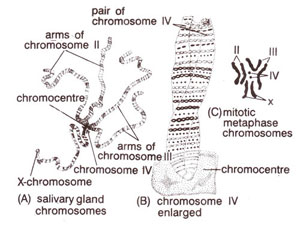In salivary gland cells of dipteran species, giant chromosomes were observed By
E.G. Balbiani for the first time in 1881. The availability of these chromosomes greatly helped the study of cytogenetics in fruitfly
(Drosophila). These chromosomes may reach a size up to 200 times (or more) the size of corresponding chromosomes at meiosis or in nuclei of ordinary mitotic cells. Another characteristic of these giant chromosomes is that they are somatically paired. Consequently the number of these giant chromosomes in the salivary gland cells always appear to be half that in the normal somatic cells. The giant chromosomes have a distinct pattern of transverse banding which consists of alternate chromatic and achromatic regions. These bands have greatly helped in the mapping of the chromosomes in cytogenetic studies. The bands occasionally form reversible
puffs, known as chromosome puffs or
Balbiani rings, which are associated with differential gene activation.
The giant chromosomes represent a bundle of fibrils which arise by repeated cycles of endo-reduplication of single chromatids. Endo-reduplication means that the chromatin replicates without cell division, as a result of which the number of chromonemata keeps on increasing. This is why these chromosomes are also popularly known as polytene chromosomes and- the condition is described as polyteny. The number of chromonemata (fibrils) per chromosome may reach upto 2000 in extreme cases. Some workers placed this figure as high as 16,000.

Fig. 6.17. Salivary gland chromosome (A, B) and mitotic chromosomes (C) of Drosophila melanogaster (redrawn from Swanson : Cytology and Cytogenetics).
In
D. melanogaster, the giant chromosomes are found in the form of five long and one short strands radiating from a single more or less amorphous mass known as chromocentre (Fig. 6.17). One long strand corresponds to the X chromosome and the remaining four long strands are the arms of II and IIIchromosomes. The centromeres of all these chromosomes fuse to form the chromocentre. In the male flies the Y chromosome is also found fused within the chromocentre and is therefore not seen as a separate strand.

Fig. 6.17. Salivary gland chromosome (A, B) and mitotic chromosomes (C) of Drosophila melanogaster (redrawn from Swanson : Cytology and Cytogenetics).
How an enormous increase in size of these chromosomes is brought about in salivary glands is not known and various hypotheses are available to explain this issue. The reader should consult Swanson's book,
Cytology and Cytogenetics, to get a relatively detailed account of these hypotheses. It should, however, be emphasized that these giant chromosomes though, commonly found in salivary glands, have also been found in malpighian tubules, fat bodies, ovarian nurse cells, gut epithelia and some other tissues.






